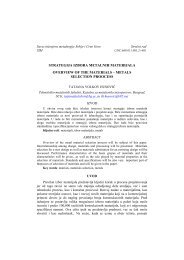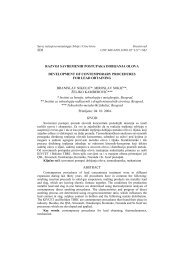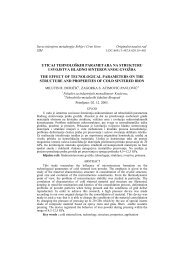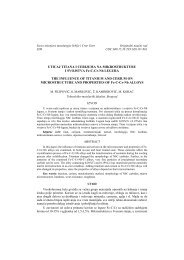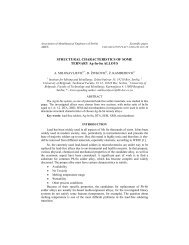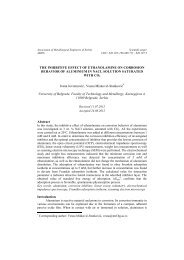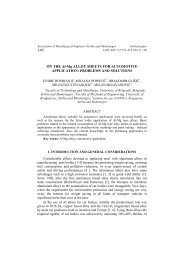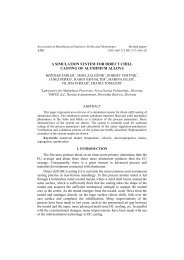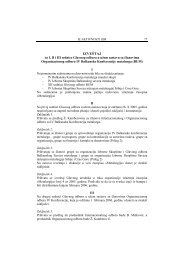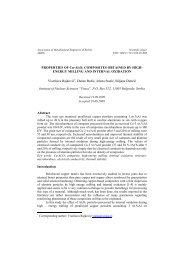possibilities of recycling of magnesium and magnesium alloys
possibilities of recycling of magnesium and magnesium alloys
possibilities of recycling of magnesium and magnesium alloys
Create successful ePaper yourself
Turn your PDF publications into a flip-book with our unique Google optimized e-Paper software.
Association <strong>of</strong> Metallurgical Engineers Serbia <strong>and</strong> Montenegro<br />
AME<br />
UDC:669.721.5.054.8=20<br />
POSSIBILITIES OF RECYCLING OF MAGNESIUM<br />
AND MAGNESIUM ALLOYS<br />
ILIJA ILIĆ, MARIJA KORAĆ,<br />
ŽELJKO KAMBEROVIĆ, JELENA PAVLOVIĆ<br />
Faculty <strong>of</strong> Technology <strong>and</strong> Metallurgy, Belgrade, Serbia <strong>and</strong> Montenegro<br />
ABSTRACT<br />
In this paper are presented results <strong>of</strong> experimental investigation <strong>of</strong> processing <strong>of</strong><br />
non oil-contaminated metal scrap based on <strong>magnesium</strong> <strong>and</strong> its <strong>alloys</strong>. These are the firs<br />
investigations <strong>of</strong> <strong>magnesium</strong> scrap <strong>recycling</strong> in Serbia <strong>and</strong> Montenegro. Experimental<br />
investigations were conducted in laboratory scale <strong>and</strong> achieved results were verified in<br />
industrial scale (Magnesium factory ″Bela Stena″ in Baljevac on Ibar). Experiments<br />
included following the influence <strong>of</strong> preparation <strong>of</strong> metal scrap on metal extraction<br />
efficiency rate.<br />
Key words: <strong>magnesium</strong>, <strong>magnesium</strong> alloy, separation, smelting<br />
1. INTRODUCTION<br />
Variety <strong>of</strong> applications <strong>of</strong> <strong>magnesium</strong> <strong>alloys</strong> in automotive industry,<br />
aerospace engineering, metallurgy, chemical industry, electro-chemistry<br />
(batteries, cathode protection, etc.) contribute to rapid increasing <strong>of</strong> production<br />
<strong>of</strong> <strong>magnesium</strong> in the world (appearance <strong>of</strong> Chinese <strong>magnesium</strong> on World Trade<br />
Market-WTM) [1-5].<br />
Magnesium is silvery-white metal that is principally used as alloying<br />
element for several non-ferrous metals [6] (Al, Zn, Pb, ...). Magnesium is<br />
among the lightest <strong>of</strong> all the metals <strong>and</strong> also the sixth most abundant on earth.<br />
Due to its light weight <strong>and</strong> with additional alloying with Al, Si, Cu, Fe, Mn, Ti,<br />
Zn superior mechanical properties could be achieved, such as: ductility,<br />
mechanical properties, high corrosion resistance, coating <strong>and</strong> castability (diecasting<br />
<strong>and</strong> pressure casting). This fact contributed increasing <strong>of</strong> the variety <strong>of</strong><br />
applications <strong>of</strong> this metal. Production <strong>of</strong> <strong>magnesium</strong> in the world increased<br />
from 20 000 t/year in 1937 up to 400 000 t/year in 2000 year, from which only<br />
in China was produced 170 000 t <strong>of</strong> <strong>magnesium</strong> in 2000 [7]. Appearance <strong>of</strong>
262<br />
MJoM<br />
METALURGIJA - JOURNAL OF METALLURGY<br />
China as a great world producer <strong>of</strong> <strong>magnesium</strong> in period 1995/96 caused<br />
decreasing <strong>of</strong> <strong>magnesium</strong> price on WTM.<br />
Simultaneously with increasing <strong>of</strong> application <strong>and</strong> consumption <strong>of</strong><br />
<strong>magnesium</strong> new significant quantities <strong>of</strong> scrap are generated, scrap from<br />
production as well as postconsumer scrap. If <strong>magnesium</strong> usage in automobile<br />
industry continuous to grow at the rapid pace that it has in past few years, than<br />
this growth could have significant immediate <strong>and</strong> long-term effects for the<br />
<strong>magnesium</strong> <strong>recycling</strong> industry worldwide. The immediate effect would be a<br />
huge increase in the quantity <strong>of</strong> new scrap generated because about 50% <strong>of</strong> the<br />
weight <strong>of</strong> input material becomes new scrap. As a result <strong>of</strong> this anticipated<br />
increase in new scrap generation, companies are planning new <strong>magnesium</strong><br />
<strong>recycling</strong> plants or they are exp<strong>and</strong>ing existing capacity. The principal longterm<br />
effect is that after an automobile is junked, the <strong>magnesium</strong>-containing<br />
parts may be removed from the automobile <strong>and</strong> recycled. These additional<br />
<strong>magnesium</strong>-containing parts would result in additional quantities <strong>of</strong> old scrap as<br />
a source <strong>of</strong> supply. The projected increase in the use <strong>of</strong> <strong>magnesium</strong> in this<br />
application has promped other developed countries such as Germany, Japan,<br />
Great Britain, USA <strong>and</strong> Canada to install additional <strong>magnesium</strong> <strong>recycling</strong><br />
capacity [8]. In USA in 1998 the <strong>recycling</strong> efficiency rate for <strong>magnesium</strong> was<br />
estimated to be 33%. Out <strong>of</strong> total quantity <strong>of</strong> <strong>magnesium</strong> scrap 25% is<br />
postconsumer scrap.<br />
In our country situation is quite different. Primar production <strong>of</strong> <strong>magnesium</strong><br />
stopped in year 2000 because <strong>of</strong> low price <strong>of</strong> this metal on WTM. In the<br />
meantime in Foundry <strong>of</strong> Magnesium factory ″Bela Stena″ in Baljevac on Ibar<br />
preparation <strong>of</strong> <strong>magnesium</strong> scrap began, with influence from ″COMESIM″,<br />
France. With this aim during 2003 on Faculty <strong>of</strong> Technology <strong>and</strong> Metallurgy in<br />
Belgrade in Laboratory for Extractive Metallurgy experimental investigation <strong>of</strong><br />
<strong>magnesium</strong> scrap preparation was conducted. Also investigation in industrial<br />
scale was done in Foundry <strong>of</strong> Magnesium Factory, but without adequate<br />
processing technology, concerning in the first place preparation <strong>of</strong> scrap.<br />
2. RESULTS<br />
New <strong>magnesium</strong> based scrap typically is categorized into one <strong>of</strong> four types.<br />
Type I is high-grad scrap, generally materials such as gates, runners <strong>and</strong><br />
drippings from die-casting operations that is uncontaminated with oils. Types II,<br />
III <strong>and</strong> IV are lower graded materials. Type II is oil-contaminated scrap, type III<br />
is dross from <strong>magnesium</strong>-processing operations, <strong>and</strong> type IV is chips <strong>and</strong> fines.<br />
Old <strong>magnesium</strong>-based scrap or postconsumer scrap consists <strong>of</strong> such<br />
materials as automotive parts, helicopter parts, lawnmower decks, used tools<br />
<strong>and</strong> the like. This scrap is sold to scrap processors. In addition to <strong>magnesium</strong>based<br />
scrap, significant quantities <strong>of</strong> <strong>magnesium</strong> are contained in aluminium<br />
<strong>alloys</strong> that also can be recycled.
POSSIBILITIES OF RECYCLING OF MAGNESIUM … 263<br />
Most <strong>of</strong> <strong>magnesium</strong> scrap is generated in foundries <strong>of</strong> <strong>magnesium</strong> <strong>alloys</strong>. In<br />
making <strong>magnesium</strong> alloy die-casting, about 50% <strong>of</strong> the material ends up as a<br />
finished product, <strong>and</strong> the remainder as new scrap. Of the scrap generated in diecasting<br />
process, about 80% end up as trimmings; 8% as dross; 7% as chips;<br />
4.5% as rejected parts <strong>and</strong> the remaining 0.5% as slurry, which is probably lost.<br />
For experiments deoiled scrap was used, which was provided by<br />
Magnesium Factory through ″COMESIM″, France, apropos their regional <strong>of</strong>fice<br />
in Belgrade. As average sample for experiments cca 60kg were taken from so<br />
called ″Big-Bags″, in which scrap was brought to Baljevac. Deoiled scrap was<br />
classified into three classes: massive ″good″ parts, massive ″bad″ parts <strong>and</strong> light<br />
fractions. Dimensions <strong>of</strong> massive ″good″ parts extends from 20 to 200 mm,<br />
thickness <strong>of</strong> 15-90 mm. Dimensions <strong>of</strong> massive ″bad″ parts extends from 30 to<br />
100 mm, thickness <strong>of</strong> 20-30 mm. Dimensions <strong>of</strong> light fractions extends from 10<br />
to 20 mm, thickness <strong>of</strong> 0.5-1 mm. All three classes are scrap from from<br />
automobile parts industry, mostly from foundries. Usually they are <strong>magnesium</strong><br />
<strong>alloys</strong> with 4-6% Al.<br />
In purpose <strong>of</strong> preceding <strong>of</strong> optimal solution for valorization <strong>of</strong> metal from<br />
scrap investigation wee conducted concerning preparation <strong>and</strong> smelting.<br />
Operation <strong>of</strong> preparation consists <strong>of</strong>:<br />
- mechanical treatment in drum <strong>and</strong> separation from dust,<br />
- chemical treatment in sulphuric acid solution,<br />
- drying.<br />
Smelting was conducted in induction furnace, 25kVA with graphite<br />
crucible <strong>of</strong> 1dm 3 .<br />
Metal extraction efficiency rate was tracked down. Results are presented in<br />
Tables 1 <strong>and</strong> 2.<br />
Table 1 - Results <strong>of</strong> experimental investigation <strong>of</strong> preparations <strong>and</strong> smelting <strong>of</strong><br />
massive ″good″ parts<br />
No.<br />
preparation<br />
mass<br />
smelting salt, g<br />
mechanical chemical<br />
<strong>of</strong><br />
sample, g<br />
mass <strong>of</strong><br />
metal, g<br />
smelting loss, %<br />
metal extraction<br />
efficiency rate, %<br />
1<br />
2<br />
3<br />
4<br />
without preparation,<br />
direct smelting<br />
drum treatment 1h<br />
<strong>and</strong> screening<br />
mechanical<br />
treatment 1h,<br />
treatment 5% H 2 SO 4<br />
drying 100°C<br />
chemical treatment<br />
5% H 2 SO 4 drying<br />
100°C<br />
- 1000 950 9.0 91.0<br />
50 1257 1180 4.8 93.8<br />
- 2000 1824 4.7 91.2<br />
- 1605 1140 5.1 71
264<br />
MJoM<br />
METALURGIJA - JOURNAL OF METALLURGY<br />
Table 2 - Results <strong>of</strong> exprimental investigation <strong>of</strong> preparations <strong>and</strong> smelting <strong>of</strong><br />
massive ″bad″ parts<br />
No.<br />
preparation<br />
mechanical chemical<br />
Smelting<br />
salt, g<br />
mass <strong>of</strong><br />
sample, g<br />
mass <strong>of</strong><br />
metal, g<br />
Smelting<br />
loss, %<br />
metal extraction<br />
efficiency rate,<br />
%<br />
1<br />
2<br />
3<br />
mechanical treatment<br />
1h<br />
mechanical treatment<br />
1h<br />
chemical treatment<br />
5% H 2 SO 4 washing<br />
drying 100°C<br />
- 2000 850 52.9 47.1<br />
100 2080 820 56.0 44.0<br />
- 1820 740 54.0 46<br />
Because with mechanical treatment in drum <strong>and</strong> screening all metal oxide<br />
could not be disposed, chemical treatment was conducted with solution <strong>of</strong><br />
H 2 SO 4 . Also solution concentration <strong>and</strong> time <strong>of</strong> chemical treatment were<br />
investigated, <strong>and</strong> conclusion is that optimal concentration is 5-8 wt.% <strong>and</strong> time<br />
1-5 min. Temperature <strong>of</strong> solution became from the exothermal reaction 45-<br />
50°C.<br />
For verification <strong>of</strong> presented laboratory results tests in industrial scale were<br />
performed in Foundry <strong>of</strong> Magnesium Factory.<br />
Sample for preparation (classification, screening, chemical treatment <strong>and</strong><br />
drying) was take from 36 ″Big-Bags″ in amount <strong>of</strong> 43 235kg. After preparation,<br />
manual classification into three classes: massive ″good″ <strong>and</strong> massive ″bad″<br />
parts was conducted. Separated massive ″bad″ parts were layed aside. Rest was<br />
screened on screen 10×10 mm. Fraction +10 mm was merged with massive<br />
″good″ parts for further processing. Light fraction, -10 mm, wasn't processed<br />
any further. In this way quantity <strong>of</strong> 5 582 kg from 13% <strong>of</strong> separated scrap was<br />
separated. Quantity <strong>of</strong> 1 544 kg <strong>of</strong> so called ″rods″ was added. For chemical<br />
treatment total amount <strong>of</strong> scrap was 7 126 kg. Chemical treatment <strong>of</strong> prepared<br />
scrap was performed by usage <strong>of</strong> steel scuttle with sifter 10×10 mm. The scuttle<br />
with scrap was immerged by crane in tub with 5% H 2 SO 4 , <strong>and</strong> pulled through<br />
the tub with water running during washing. After washing 6 597 kg was gained,<br />
meaning the mass loss was 7.43%. Preparated scrap was dried 6-8h in<br />
containers above opened furnace. After scrap was put in the crucible <strong>and</strong><br />
additionally dried for 6-8 h on 200°C. Afterwards furnace temperature was<br />
settled on 800°C, <strong>and</strong> casting was conducted on 750°C. During smelting<br />
mixture <strong>of</strong> smelting <strong>and</strong> refining salt was added in quantity <strong>of</strong> 420 kg. When<br />
total quantity <strong>of</strong> scrap was smelted molten metal was poured into crucible in<br />
order to separate the metal from slag. Metal without slag was then heated on
POSSIBILITIES OF RECYCLING OF MAGNESIUM … 265<br />
750-800°C, refined <strong>and</strong> casted in ingots. Process-technological scheme <strong>of</strong><br />
preparation <strong>and</strong> processing <strong>of</strong> non oil contaminated <strong>magnesium</strong> scrap is<br />
presented in Fig. 1.<br />
1.Forklift, 2.Bunker, 3.Screen (300×300), 4.Vibro-screen (10×10), 5.Conveyer,<br />
6.Sorting conveyer, 7.Drum, 8. Vibro-screen, (10×10) 9.Plastic basket 10.Tab<br />
11.Chemical treatment 12.Drying 13.Smelting furnace 14.Neutralization<br />
Fig.1 - Process-technological scheme <strong>of</strong> preparation <strong>and</strong> processing <strong>of</strong> non oil<br />
contaminated <strong>magnesium</strong> scrap<br />
Total mass <strong>of</strong> gained metal in this way was 5 592 kg. Quantity <strong>of</strong> metal<br />
which was inputet in furnace was 6 372 kg, which means that metal extraction<br />
efficiency rate was:<br />
5592<br />
= ⋅100<br />
= 88.4%<br />
6 372<br />
η (1)
266<br />
MJoM<br />
METALURGIJA - JOURNAL OF METALLURGY<br />
3. CONCLUSION<br />
Experimental investigations <strong>of</strong> <strong>recycling</strong> <strong>of</strong> <strong>magnesium</strong> scrap conducted on<br />
Faculty <strong>of</strong> Technology <strong>and</strong> Metallurgy <strong>and</strong> Foundry <strong>of</strong> Magnesium factory<br />
″Bela Stena″ show that:<br />
- processing <strong>of</strong> this kind <strong>of</strong> scrap is possible with metal extraction<br />
efficiency rate in range 45-90 %, depending on quality <strong>of</strong> scrap,<br />
- in purpose <strong>of</strong> achieving satisfying techno-economical effects it is<br />
necessary to have suitable processing technology, which includes<br />
preparation, metallurgical processing, smelting <strong>and</strong> refining.<br />
Basing on the experimental results it is possible to project processing<br />
technology <strong>and</strong> in dependence on location <strong>and</strong> conditions suitable different<br />
main projects.<br />
REFERENCES<br />
[1] www.efunda.com/materials/<strong>alloys</strong>/<strong>magnesium</strong>/<strong>magnesium</strong>.cfmsearch_strin<br />
g=<strong>magnesium</strong><br />
[2] http://www.aist.go.jp/aist_e/latest_research/2001/20011203/20011203.html<br />
[3] www.<strong>magnesium</strong>.com/w3/databank/article.phpmgw=196&<strong>magnesium</strong>=274<br />
[4] www.imet.tu-clausthal.de/mr/eng.html<br />
[5] M. B. Altman, A. A. Lebedev, M. B. Pruhrov, Plavka i litje legkih splavov,<br />
Metalurgija, moskva, 1969.<br />
[6] M. A. Ejdezon, Metalurgija magniji i drugih legkih metallov, Metalurgija,<br />
Moskva, 1964.<br />
[7] R. Vračar, Metalurgija magnezijuma i legura magnezijuma, Naučna knjiga,<br />
Beograd, 1998.<br />
[8] Deborah A. Kramer, Magnesium Recycling in the United States in 1998,<br />
U.S. Geological Survey, Reston, Virginia, 2002




